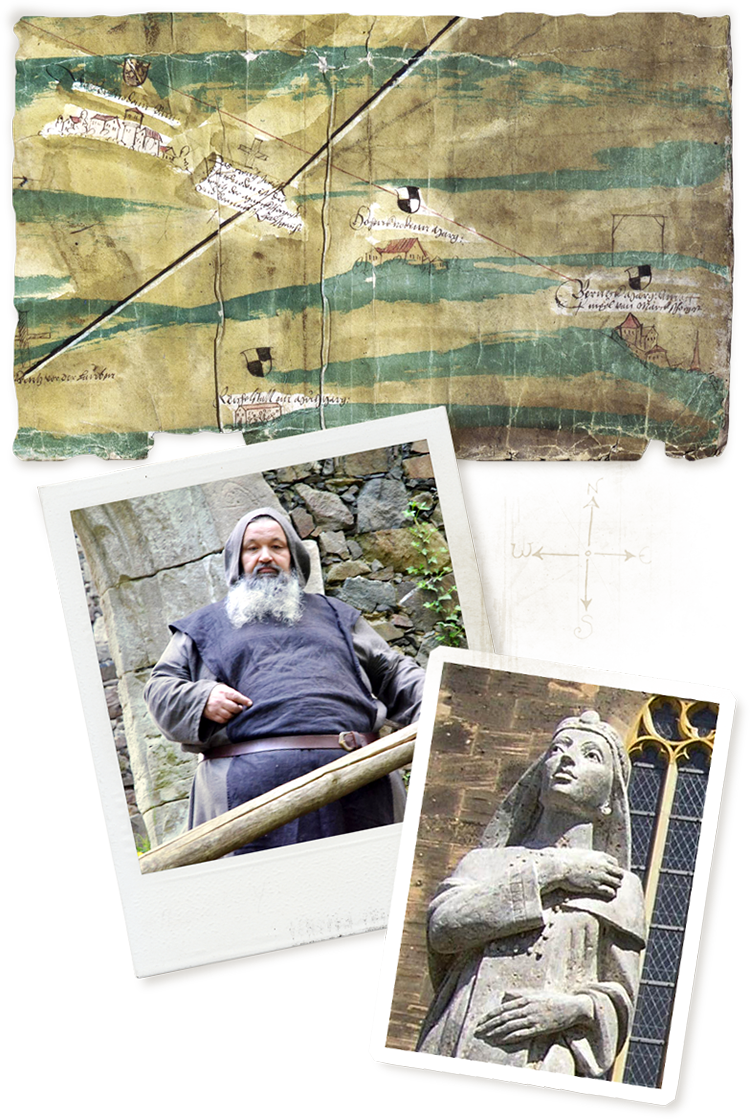
Day Trip Through the Wilderness
The road you are standing on is more than a 1000 years old. A walk up the steep path towards the castle Hohenberneck will give you a sense of the laborious travel route awaiting travelers braving their way through the mountains of the Fichtelgebirge.
Nowadays, it’s hard to imagine that this path, which connected Rome with the Baltic Sea, used to be something like the motorway today, only with ox carts and horse coaches instead of trucks and cars.
The mounts were changed in Berneck, then a full day’s trip through the wilderness of the mountains was ahead. Often, extra oxen were put on the yoke to pull the coaches and wagons up the mountain. Downhill, braking pads were hired out for the wheels. It was more comfortable to cross this trail on foot than as a passenger on the shaking carts. For the citizens of Berneck, this road meant good business. In addition to the hire of extra oxen and braking pads, and the sale of refreshments and provisions to travellers, toll money was collected for safe passage.

Via Imperii – A major trade and pilgrim route

In the Middle Ages, the Via Imperii linked Italy with the Baltic region and was thus one of the most important trade and pilgrim routes of the Middle Ages.
In the stretch from Nuremberg to Leipzig, Berneck was a third of the distance to Leipzig.
In the vicinity of today’s Bad Berneck, the Via Imperii ascends around 120 meters in a short distance.
The ascent and descent along the Knoden valley or in the heights of Rimlas required not only a station for refreshment and coaching services, but also tolls for safe passage.
The early highways were sited preferably on ridges in order to make longer use of daylight. The views were better from the ridges, and there was less vegetation to provide cover for highwaymen.
From the 10th to the 15th century, in a radius of less than two kilometers around the Bernecker core town, a total of six major and minor fortifications as well as a chapel with balistrariae (arrow slits) were built. The Old Castle, St. Mary’s Chapel and Hohenberneck are preserved as monuments and Hohewarte and Alt- Berneck are preserved as archeological sites.
Tip: Visit QR 6 for more detailed information about these medieval monuments.
 Via Imperii – Motorway of its time
Via Imperii – Motorway of its time
Text by Claus Rabsahl
Spoken by Nigel Amson
Medieval Travel
The Medieval Reenactment Group of the ‘Association Historical Places’ give us a sense for the efforts of traveling in bygone times.
Travel Diary from 1810

(… ) so I guide you further towards romantic Berneck, close to which the region becomes exceedingly picturesque.
Since the coachman had spoken of a difficult steep ravine, some of us disembarked in a small fir forest, and while we lost sight of the carriage – which turned right around the forest – a pleasant footpath led the pedestrian further to the left.
We stood suddenly surprised at the elevation we found ourselves, as we saw before us beautiful plains spreading out through the mountains and forests of deep distant Franconia, illuminated by the sun erupting here and there between solitary floating clouds.
As we gradually stepped forward, a deep green valley entered our view that dramatically parted mountain and rock into two ridges as if pushing them under our feet.
A single cliff appears to have defied the revolutionary power of nature here, such as all-destroying time, because the valley closes at a narrow arch-like angle to its base.
The ever smaller footpath led us further on its back to the peak from which one now looks into this beautiful chasm, (in the distance to the right our carriage was again visible for a moment before sinking away between the rock walls of its own path, which winds from the heights to this valley).
No traveler here shies away from the small effort of walking – which also spares him from arduous carriage travel – and a bird’s-eye view compensates him for it.
We stood as if on the pinnacle of a temple and beheld the glory where, if not the world, then at least nature and this valley seem to offer the disillusioned a silent sanctuary – which on one side hides them from the world in the clefts of the rock, and makes peace with them again by the green and flourishing banks of the rushing mirror-bright Perlenbach at its center; and from the other side, where it culminates in a lovely rotunda, they can energize once more.
(…) certainly here is still the most beautiful mountain region in Germany, and he who has not been granted the good fortune of seeing Switzerland should walk to Berneck and will thank me.
Ludwig 1810



